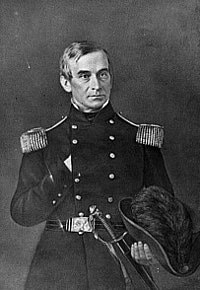Robert Anderson was an officer during the Civil War who served throughout the entire conflict but is most known for being the officer in command when Fort Sumter was fired on. Anderson was celebrated as a hero in the North and promoted to brigadier general, and given command of Union forces in Kentucky. He was removed late in 1861 and reassigned to Rhode Island before retiring from military service in 1863.

Early Life
Anderson was born at "Soldier's Retreat," the Anderson family estate near Louisville, Kentucky. His father, Richard Clough Anderson, Sr. (1750–1826), served in the Continental Army as an aide-de-camp to the Marquis de Lafayette during the American Revolutionary War and was a charter member of the Society of the Cincinnati; his mother, Sarah Marshall (1779–1854), was a cousin of John Marshall, the fourth Chief Justice of the United States. He graduated from the United States Military Academy (West Point) in 1825 and received a commission as a second lieutenant in the 3rd Regiment of Artillery.
A few months after graduation, he became private secretary to his older brother Richard Clough Anderson, Jr., who was serving as the US Minister to Gran Colombia. He served in the Black Hawk War of 1832 as a colonel of Illinois volunteers, where he had the distinction of twice mustering Abraham Lincoln in and once out of army service. He also was in charge of transporting Black Hawk to Jefferson Barracks after his capture, assisted by Jefferson Davis.
Returning to regular Army service as a first lieutenant in 1833, he served in the Second Seminole War as an assistant adjutant general on the staff of Winfield Scott and was promoted to captain in October 1841.
In the Mexican–American War, he participated in the Siege of Vera Cruz, March 9–29, 1847, the Battle of Cerro Gordo, April 17–18, 1847, the Skirmish of Amazoque, May 14, 1847, and the Battle of Molino del Rey on September 8, 1847. He was severely wounded at Molino del Rey while assaulting enemy fortifications, for which he received a brevet promotion to major.
Due to his wounds, Anderson was on sick leave of absence during 1847–48. He was then in garrison at Fort Preble, Maine, from 1848 to 1849. He then served from 1849 to 1851 as a member of the Board of Officers to devise "A Complete System of Instruction for Siege, Garrison, Seacoast, and Mountain Artillery," which was adopted on May 10, 1851. He then returned to garrison duty at Fort Preble from 1850 to 1853.
From 1855 to 1859, in view of his precarious health and probably also due to his connections to General Winfield Scott, Anderson was assigned to the light duty of inspecting the iron beams produced in a mill in Trenton, New Jersey, for Federal construction projects. He eventually received a permanent promotion to major of the 1st Regiment of Artillery in the Regular Army on October 5, 1857. He was the author of Instruction for Field Artillery, Horse and Foot in 1839.
Civil War Service
At the time of the Civil War, Robert Anderson was a distinguished veteran officer with experience in the Mexican-American War and various Indian Wars throughout the United States.
Anderson served throughout the war in a recruiter capacity, but what he is known for is Fort Sumter. Here is a list of his actions that made him an immediate national hero:
- He moved his men from Fort Moultrie to Fort Sumter, which was more defensible.
- In February 1861, the Confederate States of America was formed and took charge. Jefferson Davis, the Confederate President, ordered the fort to be captured. The artillery attack was commanded by Brig. Gen. P. G. T. Beauregard, who had been Anderson's student at West Point. The attack began on April 12, 1861, and continued until Anderson, badly outnumbered and outgunned, surrendered the fort on April 14. Even though he was heavily outnumbered and outgunned, he was able to avoid any casualties.
- He lowered the tattered Union flag and took it with him to New York, where the largest rally in U.S. History was held.
Anderson was promoted to brigadier general and went on a successful recruiting trip. Due to his failing health, he relinquished his position to William T. Sherman.
After Robert E. Lee's surrender at Appomattox and the effective conclusion of the war, at the behest of Secretary of War Edwin Stanton, Anderson returned to Charleston in uniform. Then, four years after lowering the 33-star flag in surrender, Major General Anderson raised it in triumph over the recaptured but badly battered Fort Sumter. However, hours after the ceremony of April 14, 1865, John Wilkes Booth assassinated President Lincoln.
After the war, Anderson became a companion of the Military Order of the Loyal Legion of the United States.
In 1869, he discussed the future of the U.S. Army with the "Father of the United States Military Academy," Brevet Major General Sylvanus Thayer. Afterward, they helped establish the Military Academy's Association of Graduates (AoG).
Family Life
Robert Anderson married Eliza Bayard Clinch (1828–1905), with whom he had five children: Marie (1849–1925), Sophie (1852–1934), Eliza, Robert Jr. (1859–1879), and Duncan. Anderson was the great-grandfather of actor Montgomery Clift through his daughter Maria., although this relationship has not been definitively established by genealogical sources.
Robert Anderson suffered from an illness for much of the Civil War, and it would eventually take him from his life in Nice, France. He died October 26, 1871, and would be interred in the West Point cemetery.
Related Pages
- Wikipedia - Robert Anderson
- Civil War Trust - Robert Anderson
- Robert Anderson - Find a Grave
- Civil War Genealogy
- P.G.T Beauregard to Major Robert Anderson Primary Source
- The History Junkie's Guide to the Confederate Army Generals
- The History Junkie's Guide to the Civil War
- The History Junkie's Civil War Timeline
